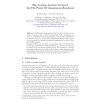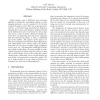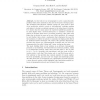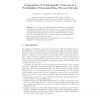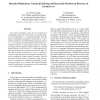SAS
1999
Springer
14 years 9 months ago
1999
Springer
ing Cryptographic Protocols with Tree Automata David Monniaux http://www.di.ens.fr/%7Fmonniaux, Laboratoire d’Informatique, ´Ecole Normale Sup´erieure, 45 rue d’Ulm , 75230 P...
IH
1999
Springer
14 years 9 months ago
1999
Springer
Abstract. Traditionally, cryptographic protocols are described as a sequence of steps, in each of which one principal sends a message to another. It is assumed that the fundamental...
CSFW
1998
IEEE
14 years 9 months ago
1998
IEEE
Model checkers such as FDR have been extremely e ective in checking for, and nding, attacks on cryptographic protocols { see, for example 11, 12, 14] and many of the papers in 3]....
CRYPTO
2000
Springer
14 years 9 months ago
2000
Springer
This paper introduces the XTR public key system. XTR is based on a new method to represent elements of a subgroup of a multiplicative group of a finite field. Application of XTR ...
CRYPTO
2000
Springer
14 years 9 months ago
2000
Springer
In this work we use cryptography to solve a game-theoretic problem which arises naturally in the area of two party strategic games. The standard game-theoretic solution concept for...
CSFW
2002
IEEE
14 years 9 months ago
2002
IEEE
Important properties of many protocols are liveness or availability, i.e., that something good happens now and then. In asynchronous scenarios these properties obviously depend on...
FCT
2003
Springer
14 years 10 months ago
2003
Springer
We develop new proof techniques, based on non-interference, for the analysis of safety and liveness properties of cryptographic protocols expressed as terms of the process algebra ...
CONCUR
2003
Springer
14 years 10 months ago
2003
Springer
We describe a probabilistic polynomial-time process calculus for analyzing cryptographic protocols and use it to derive compositionality properties of protocols in the presence of ...
LICS
2003
IEEE
14 years 10 months ago
2003
IEEE
We present decidability results for the verification of cryptographic protocols in the presence of equational theories corresponding to xor and Abelian groups. Since the perfect ...
LICS
2003
IEEE
14 years 10 months ago
2003
IEEE
We provide a method for deciding the insecurity of cryptographic protocols in presence of the standard Dolev-Yao intruder (with a finite number of sessions) extended with so-call...

